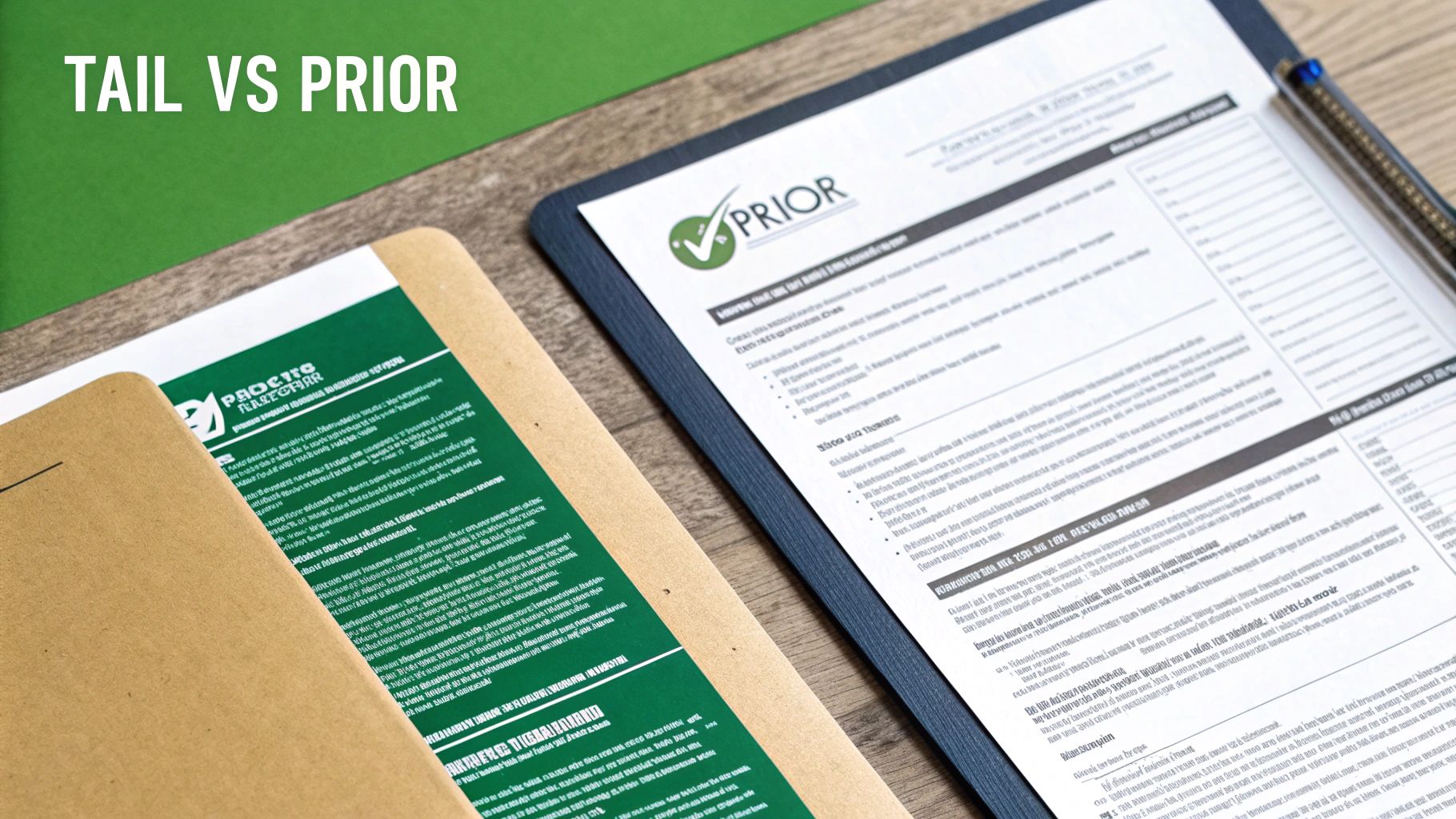So, what exactly is tail coverage? In a nutshell, it's an extension you can buy for a claims-made insurance policy after you've cancelled it. Think of it as a crucial add-on that lets you report claims down the road for incidents that happened way back when your policy was still active.
Breaking Down Tail Coverage Insurance
Let's use an analogy. Picture your professional liability insurance as a protective umbrella. With a typical "claims-made" policy, that umbrella stays open only as long as you're paying the premiums. The second you stop paying—maybe you're retiring, switching careers, or closing up shop—that umbrella snaps shut. You're left exposed to the rain from past storms.
A client you worked with two years ago could suddenly decide to sue you today. But if your old policy is no longer active, you're on your own. This is precisely the kind of gap that tail coverage is built to fill.
Think of it like an extended warranty for your past professional work. It makes sure a mistake you might have made while you were covered doesn't turn into a personal financial nightmare years later.
How Tail Coverage Fills the Gaps
Tail coverage isn't actually a new policy. Its official name is an Extended Reporting Period (ERP), and that's a perfect description of what it does. It simply extends the deadline for reporting a claim on your old, cancelled policy.
The key thing to remember is that the incident—the "wrongful act"—must have occurred during your original policy period. The claim itself, however, can be filed long after the policy has ended, as long as your tail coverage is in place.
Claims-Made Policy vs Occurrence Policy At a Glance
To really get why tail coverage is so important, it helps to see how claims-made policies differ from their counterpart, occurrence policies. This table breaks it down.
| Feature | Claims-Made Policy | Occurrence Policy |
|---|---|---|
| Coverage Trigger | The claim must be made during the policy period. | The incident must occur during the policy period. |
| When is a Claim Covered? | When both the incident and the claim happen while the policy is active. | Covers claims for incidents during the policy period, no matter when the claim is filed. |
| Need for Tail Coverage? | Yes. Essential to cover claims filed after the policy expires. | No. Coverage is tied to the incident date, not the claim date. |
| Typical Cost | Starts lower and increases over time. | Generally more expensive upfront. |
| Common For | Professional liability (doctors, lawyers, consultants), E&O. | General liability, auto insurance. |
As you can see, the structure of a claims-made policy is what creates the need for an ERP. Without it, you're left with a significant coverage gap the moment you walk away.
This protection is a fundamental piece of risk management for any professional. Properly handling these long-term liabilities is a cornerstone of a solid strategy for commercial insurance in New York or anywhere else. It’s what gives you the peace of mind to close one chapter of your career without worrying that the past will come back to haunt you.
How Tail Coverage Works in the Real World
Let's ground this in a real-world scenario. Meet Dr. Evans, a physician who's hanging up her stethoscope after a fantastic 30-year career. Throughout her time practicing, she's relied on a claims-made policy for her medical malpractice insurance—a smart, cost-effective choice for her active years.
When she retires, she cancels that policy. But Dr. Evans is savvy. She knows that a lawsuit could pop up years down the road based on care she provided long ago. So, she immediately purchases tail coverage from her insurer, making a one-time investment in her peace of mind for retirement.
This is a great illustration of how tail coverage acts as a financial shield long after your professional life is over.
Think of it as locking the door on past liabilities so you can enjoy your future.
The Claim Timeline Explained
Fast forward eighteen months into Dr. Evans’s retirement. A former patient files a lawsuit, claiming a misdiagnosis from an appointment that happened two years before she retired.
If Dr. Evans hadn't bought tail coverage, this would be a nightmare. Her old policy is inactive, so she'd be on her own, facing a massive legal and financial fight with her personal savings on the line.
Thankfully, Dr. Evans made the wise move. She simply reports the new claim to her old insurance company. Because of her tail coverage, the insurer is still on the hook. They have to defend her and cover the claim, all the way up to her original policy limits.
This story perfectly shows what an Extended Reporting Period (ERP), or tail coverage, really does.
- What it does: It extends the window of time you have to report a claim that stems from your past work.
- What it doesn't do: It won’t cover any new incidents that happen after your policy is cancelled. It also doesn't give you a higher coverage limit than you originally had.
The time limit for filing a claim is a critical piece of the puzzle, so it’s worth understanding when a claim expires. And for businesses, this forward-thinking risk management should also include things like liability insurance for employees.
Ultimately, tail coverage ensures that when you close one chapter of your professional life, you aren’t leaving yourself exposed to unfinished business from the past.
When Do You Absolutely Need Tail Coverage?
It’s one thing to grasp the concept of tail coverage, but it's another thing entirely to know exactly when it’s not just a good idea, but an absolute necessity. These are the critical moments in your career where, without a tail policy, you’re essentially betting your financial future against the odds of a past mistake resurfacing.
The most obvious trigger is retirement. After a long and successful career, the last thing you want is a surprise lawsuit wiping out your nest egg. But retirement is far from the only time you’ll need to make this decision.
Key Career and Business Transitions
Certain professional moves create immediate and serious gaps in your liability protection. You absolutely have to get tail coverage in these situations:
-
Changing Insurance Carriers: When you switch from one claims-made policy to another, your old policy’s protection vanishes the moment it expires. If your new insurance company doesn’t offer "prior acts" coverage (also called "nose" coverage) to pick up that history, you're on the hook. The only solution is buying a tail from your previous carrier.
-
Selling or Closing Your Practice: Your professional liabilities don't magically disappear when you lock the doors for the last time. A claim can pop up years after you've moved on. This is a common challenge, for example, for professionals selling your dental practice.
-
Leaving a Group Practice: Doctors, lawyers, and consultants often work under a group policy provided by their employer. The moment you walk out the door, so does that coverage. You're left completely exposed for every single client you served or patient you treated while you were there.
-
Taking a Sabbatical or Extended Leave: If you're pausing your career, you'll likely cancel your professional liability policy to save money. A tail policy is the bridge that protects you for all your past work while you're taking that well-deserved break.
Think about a tech consultant who finds a better rate and switches insurance carriers. Two years later, a lawsuit is filed over a major software bug from a project she completed under her old policy. Without tail coverage from her former insurer or prior acts coverage from her new one, she’s facing that legal nightmare alone and uninsured.
Ignoring coverage during these transitions is a massive, and frankly, unnecessary risk. For anyone running their own business, this isn't just an insurance decision; it's a fundamental part of responsible planning, right up there with things like business continuity insurance. Each of these scenarios is a crossroads where your past can come back to haunt you, making tail coverage a truly vital investment.
The Real Cost of Tail Coverage
When it comes to tail coverage, the first question on everyone's mind is usually, "What's this going to cost me?" It's a fair question. The price tag isn't just a random number; think of it as a calculated, one-time investment to safeguard your financial future.
This single, lump-sum payment might feel substantial upfront, but it’s designed to prevent a much larger problem: an uninsured claim popping up years later that could jeopardize your retirement or personal savings.
The cost is almost always calculated as a percentage of your final annual premium for your claims-made policy. The longer you want the tail to last—that is, the longer you want the ability to report old claims—the higher that percentage will be. A short tail is cheaper, but an unlimited one buys you permanent peace of mind.
Breaking Down the Numbers
So, how do those percentages actually play out? The cost of tail coverage scales directly with how long you need protection.
- A one-year tail might run you about 100% of your last annual premium.
- A three-year tail could be closer to 200%.
- An unlimited tail, the most comprehensive option, often lands around 175% to 200% of your final premium.
Those figures can seem steep, but it's crucial to weigh them against the alternative. A single professional liability lawsuit, especially if you're uninsured, can easily climb into the six- or even seven-figure range. That’s enough to wipe out a lifetime of hard work.
This one-time payment is your way of closing the books on your professional past. It’s a strategic business decision that ensures a claim from a project you completed years ago doesn’t become a personal financial crisis today.
Choosing the right tail coverage is a critical piece of your overall risk management puzzle. It complements the other protections you have in place. If you're looking to get a fuller picture of how all these policies fit together, you might find our guide on commercial insurance types helpful.
Ultimately, the cost of tail coverage is the price you pay for certainty.
Tail Coverage Across Different Industries
You might think tail coverage is just for one or two specific professions, but that’s not the case at all. It’s a critical piece of the puzzle for anyone in a high-stakes field whose past work could come back to haunt them years down the road. If your professional liability insurance is a claims-made policy, you absolutely need to know about tail coverage.
The real driver here is something called “long-tail liability.” This just means a claim can pop up long after you’ve completed the work. Because of this, tail coverage has become an essential safeguard in a few key industries.
Healthcare Medical Malpractice
For doctors, surgeons, and virtually anyone in healthcare, tail coverage isn't just a good idea—it's essential. The rules around when a patient can sue for malpractice are tricky and can stretch out for years, particularly if the patient was a child at the time of treatment. A physician who retires this year could easily face a lawsuit a decade from now for something that happened while they were still practicing.
Without solid tail coverage, that doctor would have to pay for their legal defense and any settlement out of their own pocket, putting their entire retirement at risk. It’s a standard, and necessary, part of planning for the end of a medical career.
Legal Professional Liability
Lawyers find themselves in a very similar boat. An error in a contract, a poorly drafted will, or a mistake in a legal proceeding might not come to light for years. When an attorney retires, leaves a firm, or even just changes their insurance provider, tail coverage is what stands between their past cases and their personal finances.
Securing this coverage is a fundamental step in protecting a lawyer's personal assets from the ghosts of cases past. It acts as a final, definitive backstop for a career's worth of professional advice and actions.
Technology Errors and Omissions
The tech industry is all about speed, but liability can move at a snail’s pace. An IT consultant who set up a network, a developer who wrote a piece of code, or a cybersecurity expert who signed off on a system could be blamed for a data breach or catastrophic failure that happens long after their project is over.
As more tech experts work as freelancers or contractors, understanding what is tail coverage insurance is crucial for when they move to a new project or decide to shut down their business. Beyond professional liability, tech companies often need other specialized policies like Key Person Insurance for businesses to protect against the loss of vital team members. These policies are all part of smart financial planning and are a core component of sound wealth preservation strategies.
Frequently Asked Questions About Tail Coverage
Even with a good grasp of the basics, tail coverage can leave you with some nagging "what if" questions. It's one of those things where the details really, really matter. Getting them wrong can be a costly mistake.
Let's walk through some of the most common questions professionals ask when they're trying to figure this all out.
Can I Buy Tail Coverage at Any Time?
This is a huge—and potentially disastrous—misconception. The answer is a firm no. You can't just pick up tail coverage whenever the mood strikes.
Insurers give you a very narrow window to make this decision, usually just 30 to 60 days after your claims-made policy ends. This is a one-time, take-it-or-leave-it offer. Once that window closes, it’s shut for good. If you miss it, all the work you did under that old policy is left exposed.
Is Tail Coverage the Same as Prior Acts Coverage?
It’s easy to mix these two up since they both relate to your past work. But they're actually opposites, like two different bookends on your coverage timeline.
- Tail Coverage is what you buy when you’re leaving a policy. It lets you report future claims back to your old insurer for work you did while you were with them. Think of it as closing the door on your liability with that carrier.
- Prior Acts Coverage (often called "nose" coverage) is what you get when you’re starting a new policy. It tells your new insurer, "Hey, I need you to cover my history, too." It brings your past work under the protection of your new plan.
So, one looks backward from an old policy, and the other brings your past forward to a new one.
Does My Employer Pay for Tail Coverage?
This one comes down to one thing: your employment contract. There’s no standard rule here.
In some fields, especially medicine, it's pretty common for an employer to foot the bill. They might offer it as a parting benefit, particularly if they required you to be on their specific insurance plan. For many other professions, though, the responsibility falls squarely on you, the professional. And it's a significant one-time payment. You absolutely have to check your employment agreement to know for sure.
Key Takeaway: Never assume your employer has you covered. Get the details about who pays for tail coverage in writing in your contract. An assumption here could lead to a very expensive surprise when you resign.
Is Tail Coverage Tax-Deductible?
For most business owners, independent contractors, and other professionals, the answer is yes. The IRS generally views tail coverage as an ordinary and necessary business expense, just like the premiums you pay for your regular liability insurance.
Since it’s a policy meant to protect your business assets from work-related lawsuits, it typically qualifies. Of course, tax laws have their own complexities and can change. It’s always smart to run this by your accountant or tax advisor to see how it applies to your specific financial situation.
Trying to sort through the fine print of professional liability and tail coverage can feel overwhelming. The experts at Wexford Insurance Solutions are here to help you make sense of it all and ensure you're properly protected. We provide clear, personalized guidance so you can move forward in your career without leaving yourself vulnerable.
Secure your professional future with a free consultation from Wexford Insurance Solutions
 Your Data Breach Response Plan Guide
Your Data Breach Response Plan Guide What Is a Loss Run Report? Essential Guide for Better Insurance Rates
What Is a Loss Run Report? Essential Guide for Better Insurance Rates









